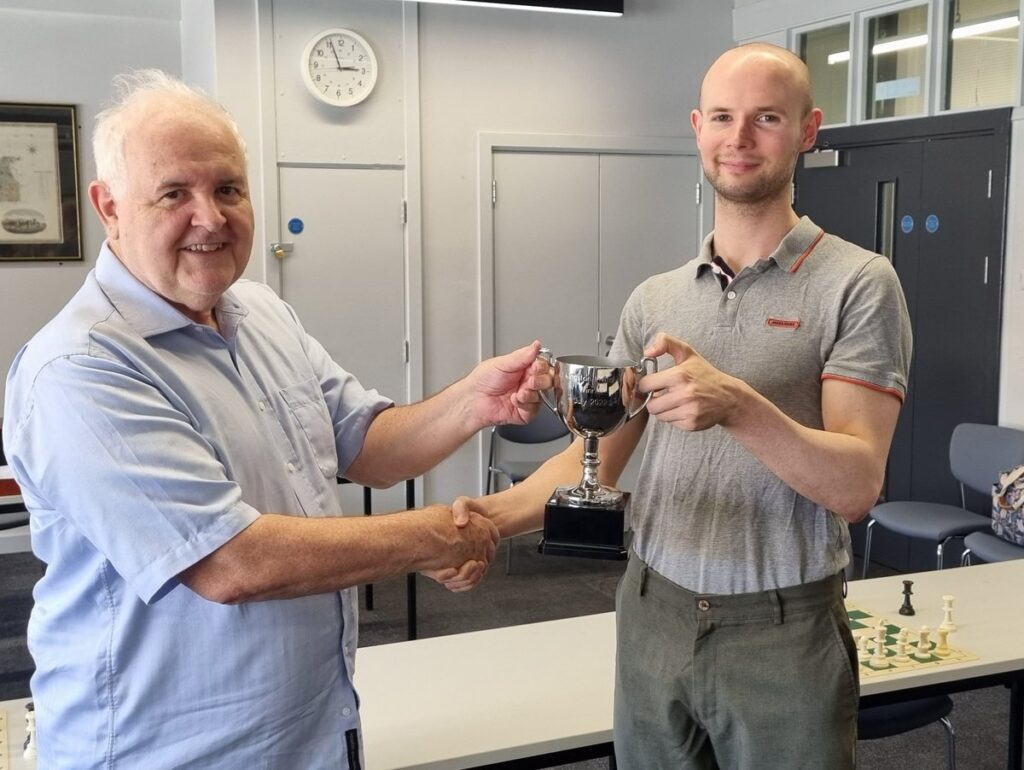
The inaugural Kingston Invitational, a Fide-rated 10-player all-play-all tournament, took place at Kingston University from 20 to 24 July 2002. This was the field:
- IM Peter Large [Fide 2299, ECF 2353]
- Steven Jones [Fide 2251, ECF 2339]
- CM David Henry Maycock Bates [Fide 2240, ECF 2295]
- FM Akshaya Kalaiyalahan [Fide 2158, ECF 2212]
- NM Peter Lalić [Fide 2151, ECF 2269]
- Michael Healey [Fide 2147, ECF 2281]
- Timothy Seymour [Fide 2076, ECF 2145]
- WCM Zoe Varney [Fide 2045, ECF 2094]
- Peter Finn [Fide 2038, ECF 2176]
- William Taylor [Fide 1959, ECF 2095]
The tournament controller is Adam Raoof, working alongside arbiters Mark Hogarth and Angus James (Lance Leslie-Smith also provided assistance with the transmission of results on the final day). There are nine games, spread over five days: two games a day on the first four days, with the final game on Sunday. The time control is 90 minutes with a 30-second increment. The prize fund is £250 to the winner, £100 for second, £50 for third. There will be a £50 best game prize, to be judged by highly rated Kingston player Vladimir Li. The pairings were published well in advance on the Chess Results server to give players ample time to prepare. Daily tournament reports will be posted below, and a selection of annotated games will eventually be published in the Games section of the Kingston website. We also hope to produce a tournament booklet.
Day 0 19 July
Tournament controller Adam Raoof christened Tuesday 19 July “Day 0” of the inaugural Kingston Invitational. On the first day of the event proper (Wednesday 20 July), Michael Healey – one of the ten players in the tournament – had an appointment to get a visa for his imminent trip to India, where he is due to captain the Welsh women’s team in the Olympiad, so his opponent Peter Large had kindly consented to play him a day early, with the game taking place at the Clissold Arms, near East Finchley tube station, as an adjunct to the Muswell Hill Rapidplay. As the rapidplayers bashed out their moves in the playing area, Healey (who had the white pieces) and Large conducted their more considered battle in an anteroom. Despite record temperatures – this was the hottest day ever recorded in the UK – 40.3°C – they kept their cool and played a complex, cagey game that took four hours to complete.
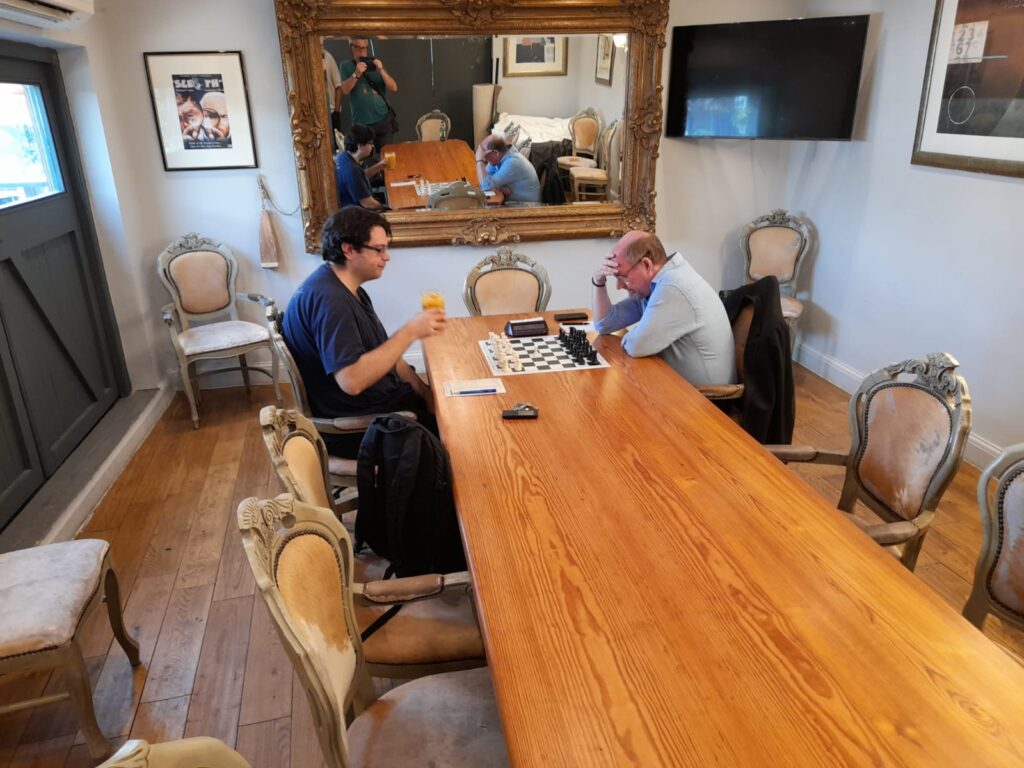
Large chose the French Defence, Mike went for the Advance Variation, and there followed a good deal of mysterious shuffling, which Mike later characterised as each side waiting for the other to make a mistake. The pivotal move may have been Mike’s 26th, when he sacrificed one of his doubled pawns on the g-file to open up Peter’s kingside. That prompted an outburst of what one of Mike’s fellow competitors calls Healey-esque “manufactured chaos” in which Mike’s beloved knights and his pair of rooks were thrown at the Black position. Large’s army were not able to withstand the battering and collapsed in short order. Healey was up and running, but the experienced Large has plenty of time to recover and is likely to be in the mix at the end of the nine rounds. Best of all, tomorrow – when we reconvene at Kingston University – is predicted to be 15 degrees cooler.
Day 1 20 July
At last we made it (initially minus Mike Healey and Peter Large) to Kingston University, where it was graduation day, which was lovely. As expected, the games in round one proved splendidly combative, and it was soon clear that this was a tournament in which any player could beat anyone else. Expect the unexpected.
Peter Lalić opened with his now familiar h3 as White against former British women’s champion Akshaya Kalaiyalahan. Playing the Jobava London System, he essayed an early g5 and established a bind on the kingside. He probed for weaknesses and there was a good deal of shuffling, with Kalaiyalahan more than holding her own, before a tiny slip – choosing the wrong square for her exposed king – allowed Lalić to unfurl a well-controlled tactical strike that ended in mate.
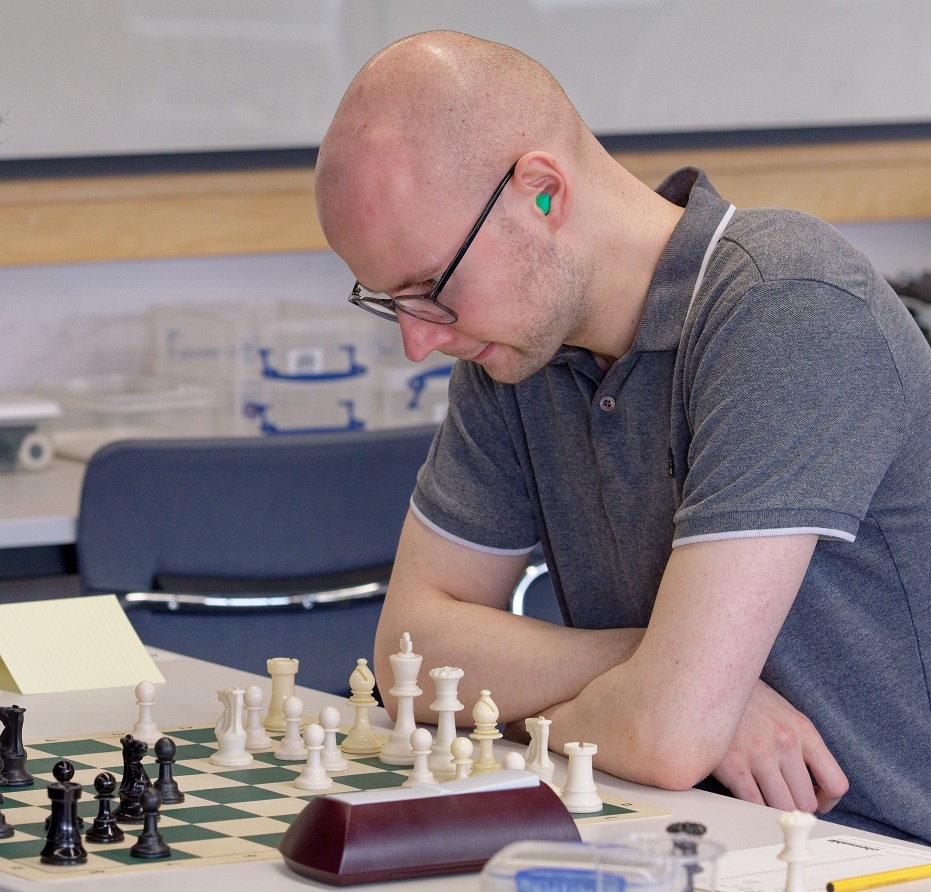
Peter Finn, playing a Sicilian, got the better of Zoe Varney in a sharp tactical battle, while Tim Seymour’s Berlin Defence against Steven Jones’s Ruy Lopez brought home the full point after Jones went wrong in a tactical melee in which a bewildering number of pieces were en prise.
That left David Maycock playing White against his Kingston teammate Will Taylor. The latter’s Petrov’s Defence seemed to surprise Maycock, who ran into ferocious time trouble and was playing on the increment before the 20th move. Gradually, though, Maycock asserted a tiny advantage and whittled away the time differential until both players were playing on the increment.
Maycock had rook and pawn against rook and tried everything he knew to win what was almost certainly a theoretical draw (theory and practice often diverge of course) in a game that took almost five hours to complete. But Taylor was resolute and secured a hard-earned and thoroughly deserved draw. Maycock, ever the perfectionist, looked briefly furious with himself, but he and Will then trooped off to a café together to relive the game.
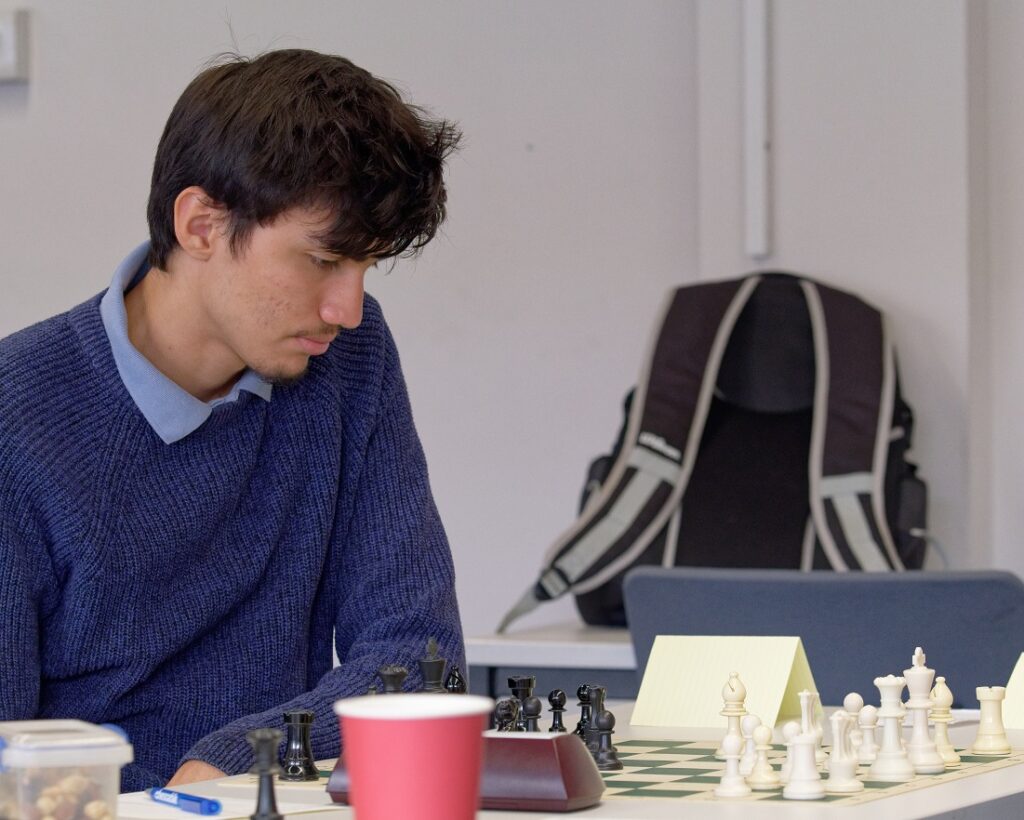
In the afternoon session, Mike Healey – still battling to get a visa for India – barely made it to the playing room in time for his game against Tim Seymour. Strictly speaking, Seymour could have claimed a default, but he said he was there to play chess and gave Mike some leeway on his arrival time. An admirable sporting gesture. When they did eventually get going, they played out what Healey later described rather gnomically as a “grandmasterly draw”. After seven hours in visa hell and with Seymour appearing to have an edge in the position, Mike looked more than satisfied with that result.

Peter Large recovered from his setback against Healey in round one with a smooth win over Peter Lalić. Large’s Nimzowitsch–Larsen Attack appeared innocuous and his doubled pawns on the e-file looked like they could be problematic, but he had it all perfectly under control and by move 35 – with the major pieces exchanged and a white bishop v black knight endgame developing – it was clear that he had two unstoppable central pawns. Lalić resigned.
Will Taylor, after his first-round heroics, had another draw, this time against Akshaya Kalaiyalahan, though he admitted there was an element of good fortune in the result. David Maycock, with his second White of the day and playing a Ruy Lopez, chalked up his first win of the tournament with an impressive and tactically energetic victory over Zoe Varney. And in a game that finished a good hour after the others, Steven Jones squeezed out a win against Peter Finn in another knight v bishop endgame which, thanks to the advance of three linked pawns, he always seemed the likelier to win, despite playing on the increment for a long period.
Soon after 8pm and after nine hours of tough chess, we called it a day. Incredibly, we have to do it all again tomorrow. Two Fide-rated games a day is no walk in the park. As the Finn-Jones game ended, the rain started to fall – the first for weeks in south-west London – so for the moment walks in the park were out on all fronts.
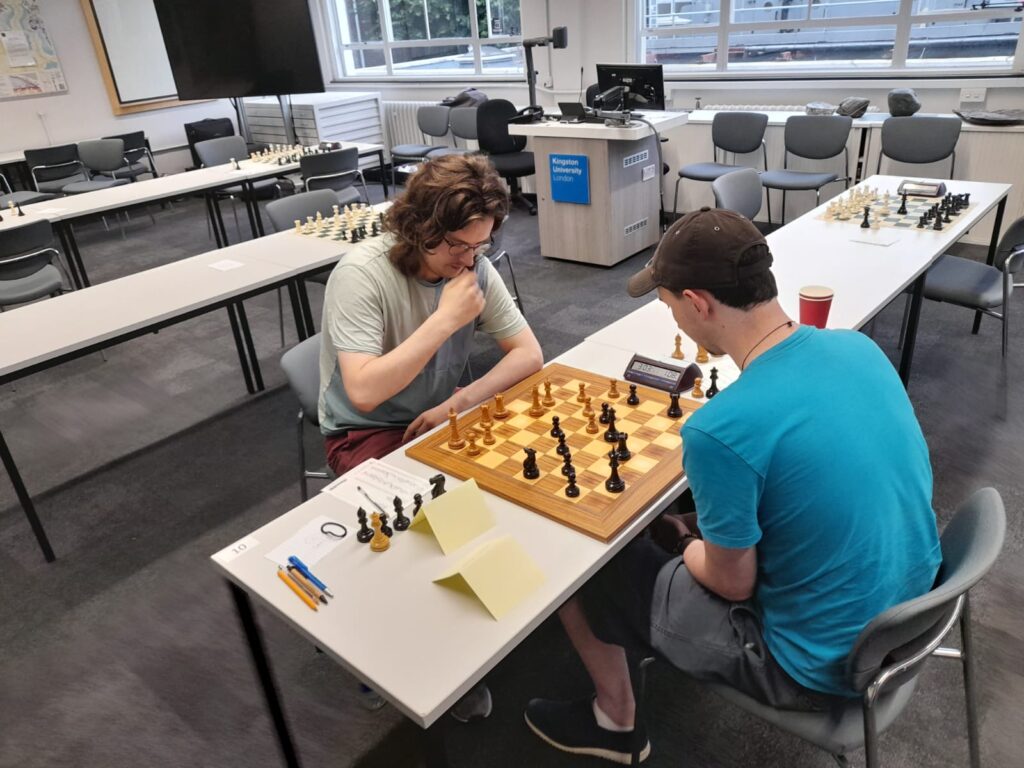
Day 2 21 July
Another hot day – both climatically and chesswise. Steven Jones hit bus trouble on the way to Kingston University and was 40 minutes late for the start of his game with David Maycock – not someone to whom you want to give a headstart. Jones came up with a very clever solution: the Zaitsev Variation of the Ruy Lopez, which holds out the prospect of an early forced draw by repetition. That is exactly what transpired, with Maycock far too principled a player to keep the game going by playing an inferior move.
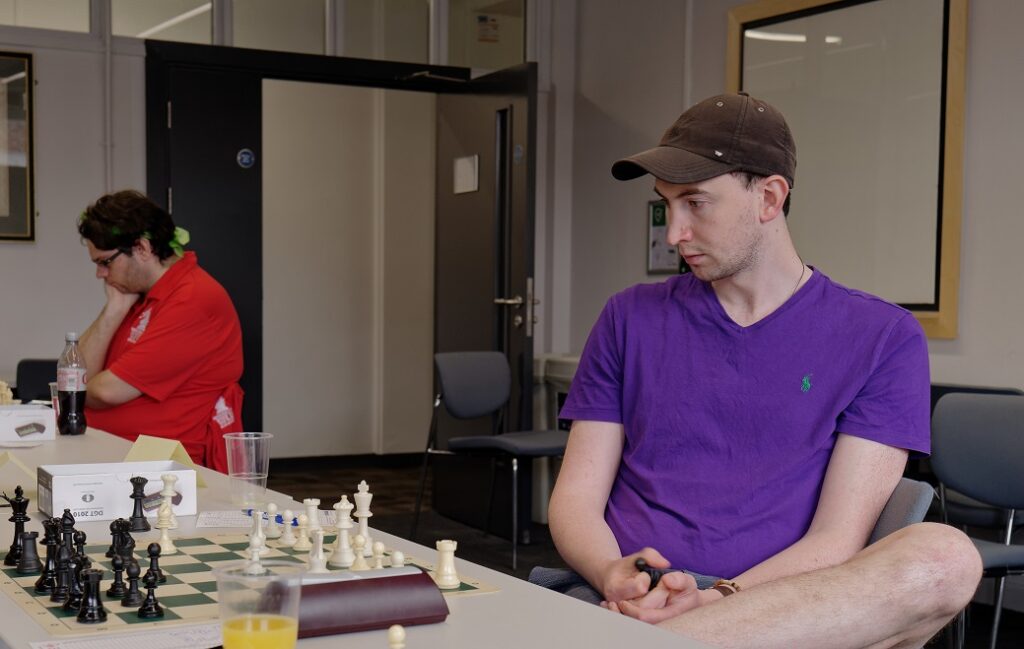
Tim Seymour was on the back foot throughout against Peter Lalić, whose much-derided 1. h3 has stood him in good stead so far in this tournament. The opening led straight into the endgame where White was slightly better due to an advantage in development. Having an unsecured king, Black needed to play accurately, but a mistake on move 21 resulted in a position that was plain lost and the game was done within 30 moves.
Akshaya Kalaiyalahan, with White, played an excellent game against IM Peter Large. She was pleasantly better in the endgame and continued to press, with the evaluation oscillating between slightly better and clearly better for White. On move 34, however, Black managed to activate his knights and finally equalised. The game ended shortly afterwards in a draw by repetition.
Zoe Varney played adventurously as White against Will Taylor, but overreached and allowed Taylor to gain an edge. Time trouble was, however, looming for Taylor – a feature of both his games today – and he decided to force another draw by repetition, the theme of the morning.
The real drama came in the final game of the session – a no-holds-barred clash between Mike Healey, with White, and Peter Finn. The opening was a variant of the Closed Sicilian, with opposite side castling. Black obtained strong counterplay and a built a decent advantage. The position became very sharp, both kings were under threat, and the evaluation was swinging wildly.
Eventually, Finn was material up and objectively close to winning, but Healey retained practical chances with counterplay against Black’s exposed king. Humanly, it was not an easy position to play, with both sides short on time. But Finn’s clock trouble was the greater – he had been playing on the increment for a while – and, despite a generous 30-second allowance per move, he froze and lost on time. A horrible way to go down after playing a terrific game. To his credit, he took it like a trouper and sat there for half an hour after the grisly conclusion of the game analysing with Healey, whose win took him to the top of the third-round leaderboard.

Finn had a dramatic day because in the afternoon he played another furious mate-or-be-mated game against Peter Lalić, not a player you want to face after a traumatic morning game. Lalić played the French Defence; Finn opted for the Winawer Advance Variation and targeted Black’s kingside with an attack that looked potentially devastating. But Lalić counter-punched, Finn had overlooked the weakness of his own uncastled king and, after 22 brutal moves, the struggle was over. Not a happy day for Finn, but he could at least laugh about it. “I may not win the brilliancy prize,” he remarked, “but I do think I’m playing the most interesting chess.”
The game between David Maycock and Mike Healey was a classic clash of styles: the adventurous, sometimes anarchic improvisational genius of Healey against the cold, hard calculation of the 18-year-old Maycock, a player whose official Fide is 2240 but who many observers think is already IM strength. Healey, playing Black, spent some time moving his knight back and forth and prematurely resolved the tension in the centre. That allowed Maycock, with White, to obtain a better pawn structure and more harmonious piece placement. Characteristically, Healey attempted an all-out attack in an effort to muddy the waters, but Maycock was precise and converted his material and positional advantage. The win took meant he leapfrogged Healey in the leaderboard, where after four rounds he is level at the top with Peter Lalić on 3/4.
The game between Zoe Varney and Steven Jones saw an interesting position, with opposite-side castling in a closed French-type structure. But the experienced Jones, with Black, slowly outmanoeuvred Varney and won in the endgame by crushing through on the kingside. In the game between Tim Seymour and Akshaya Kalaiyalahan, an early blunder by Black left White with a clear extra pawn and an advantage in development. The Black queen was hopelessly hemmed in, and Kalaiyalahan’s rooks were equally becalmed. She fought on, but defeat was inevitable.
In the final game, which finished at close to 8pm, Will Taylor with White obtained a substantial advantage out of the opening against Peter Large, but Black fought back and by move 15 had managed to develop his pieces and establish central control. The next 20 moves were marked by a good deal of cagey manoeuvring where the evaluation did not deviate far from equality. But with Taylor playing on the increment, Large eventually managed to harmoniously place his heavy pieces on the kingside and won the game with a direct attack. That took Large to 2.5/4, and the leaders would be wise to keep a beady eye on him as he tucks menacingly into their slipstream.
Day 3 22 July
Kingston members had been looking forward to the fifth-round game between Peter Lalić and David Maycock for weeks, and it did not disappoint. Five hours, 125 moves, a rook endgame of enormous complexity skilfully played by both sides, and finally heroic defence by Maycock when faced with rook and two pawns against rook. A magnificent game that underlined the talent of both players and the extraordinary fighting qualities of Maycock, who turned down a draw when he was objectively worse. It may not be the way to win tournaments – he paid for his morning exertions with a loss to Akshaya Kalaiyalahan in the afternoon – but you can’t help but admire the fighting spirit and sheer tenacity.
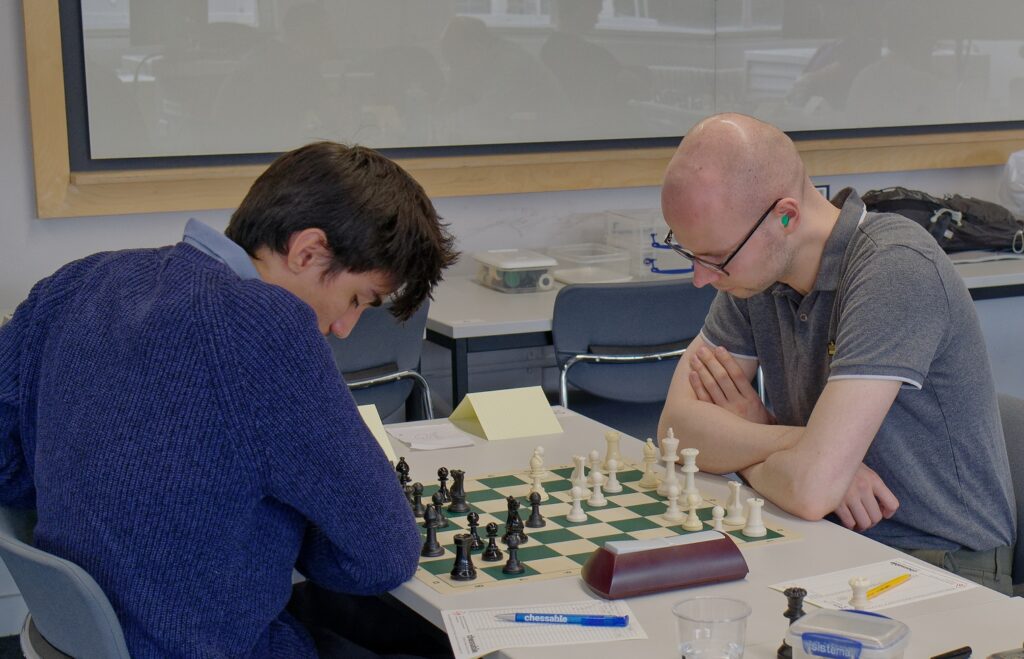
Zoe Varney gained her first win of the tournament when she upended Mike Healey. Varney, with Black, equalised comfortably and the position promised a strategical manoeuvring game, but Healey played a bit too aggressively and overextended himself on the kingside. Black took advantage of the created weaknesses and eventually converted the position into a full point.

Peter Large, with White, defeated Tim Seymour in a Ruy Lopez anti-Berlin. The innocent-looking move 8… h6 allowed White to establish central control and develop an initiative. In a few moves, Large had obtained material advantage, which he duly converted on move 34. An impressive game by the IM, bearing out the prediction that his first-round loss to Healey by no means undermined his claims as tournament favourite.
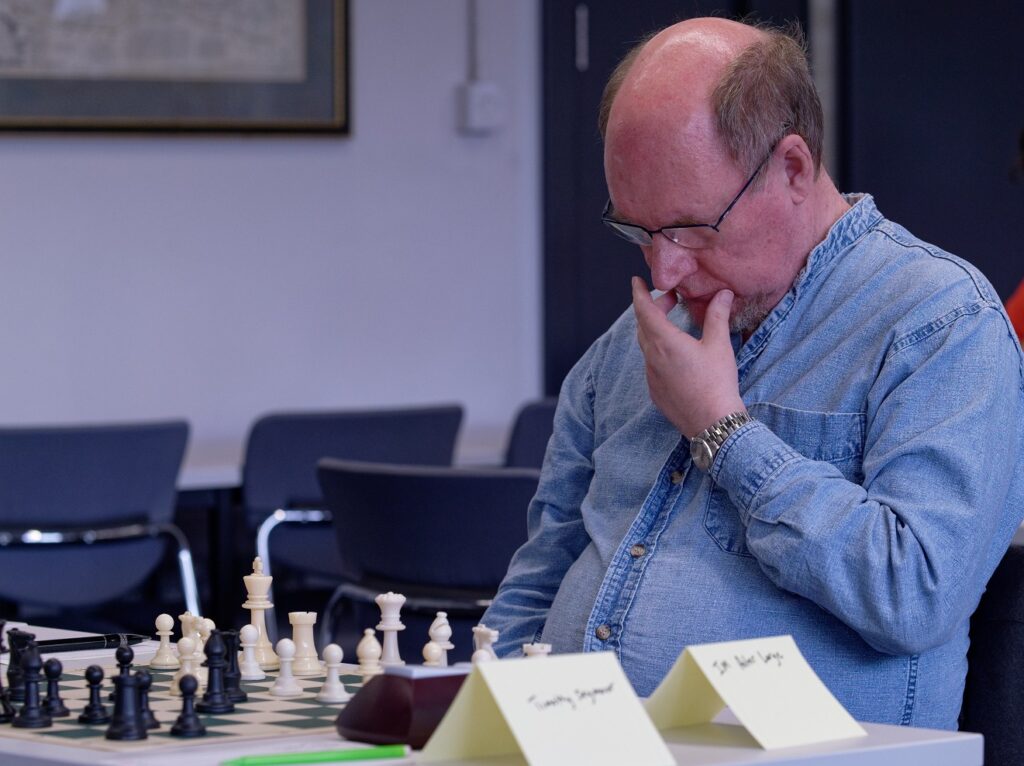
Steven Jones, playing White, was able to break down Will Taylor’s previously sturdy Petroff Defence. Black lost a few tempi moving his queen, neglecting the queenside development. White’s development advantage allowed him to finish the game on move 26 via concrete tactical means.
In the final game of the round, Akshaya Kalaiyalahan, with White, temporarily sacrificed a pawn against Peter Finn, but regained it under unfavourable circumstances. Finn did not manage to convert his advantage in piece activity and eventually found himself in a pawn-down endgame (rook, bishop and three pawns v rook, bishop and two pawns). Black allowed a transposition into a pawn endgame, which looked holdable. The engine shows that Kalaiyalahan missed a study-like win on move 45, but it was far from obvious and the game ended in a draw.
The Lalić-Maycock game had taken so long that the afternoon round – the sixth – started half an hour late at 4.30pm. After his lengthy morning game, Maycock may have suffered a reaction because he uncharacteristically miscalculated against Kalaiyalahan. The opening had produced a rich and dynamically balanced position, and Maycock went for a tactical operation chasing Black’s queen, but it turned out to be flawed. Kalaiyalahan won two pawns and soon converted her material advantage.
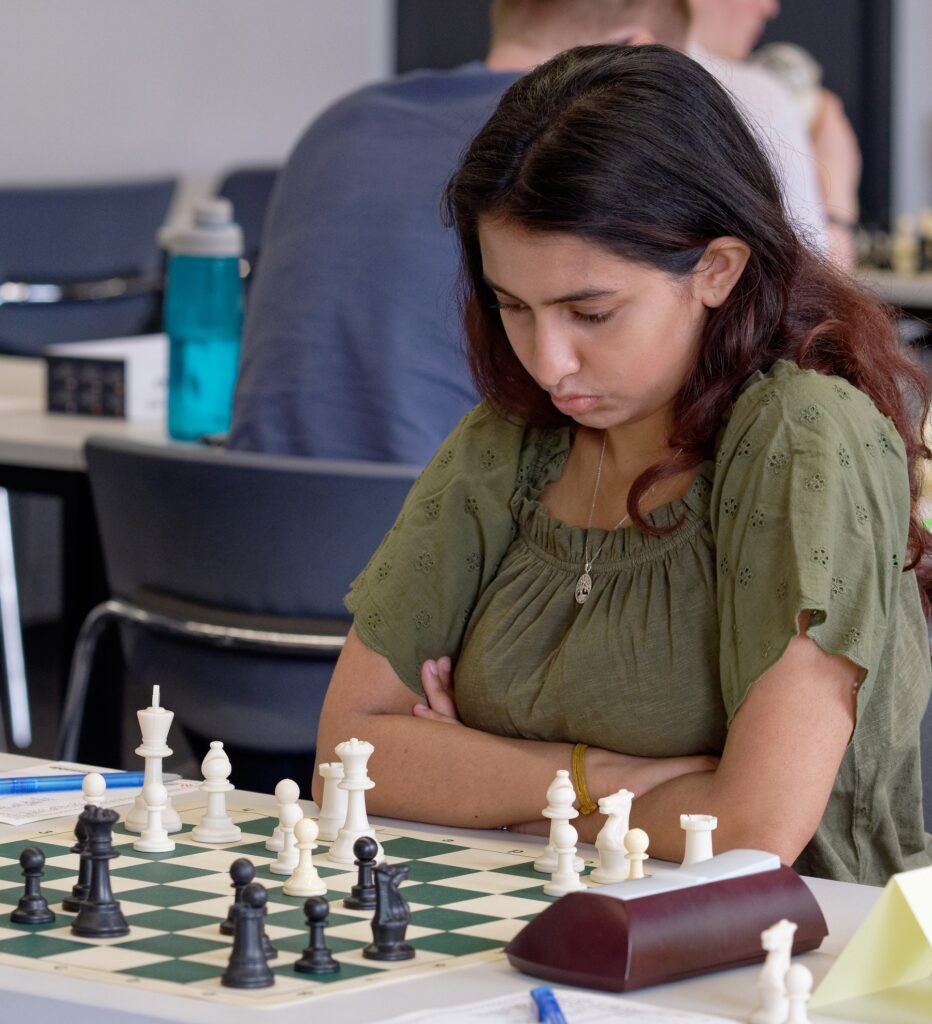
Finn, with White, and Large played a Rossolimo Sicilian. Due to a few early inaccuracies, Black ended up two pawns down for no compensation. Large said later that he thought he was objectively lost, but Finn – who reckoned his opponent did have some compensation for the two pawns – played indecisively, returned one pawn and blundered another one, after which his game went downhill quickly. With neat tactics, Large won the exchange and converted it into a full point.
Taylor, with White, and Seymour played a Caro-Kann – one of the modern mainlines where Black castles short and moves his h-pawn down to h4. White played passively and allowed Black to harmoniously place all his pieces and advance the pawn to h3, weakening White’s king. Black retained the initiative, with some potential tactics against White’s king hanging in the air, but in mutual time trouble a draw was agreed.
Peter Lalić won an impressive game against Zoe Varney, who was playing White. An opening inaccuracy by Varney led to a strategically tricky queenless middlegame in which White had chronically weak light squares along with issues with development. Lalić won with a direct attack on those light squares.
In the final game to finish, Steven Jones, with White, defeated Mike Healey in a Ruy Lopez, Classical Defence. Jones obtained a positional advantage out of the opening due to the weakness of the d5 square – with black pawns on c5 and e5, and white pawns on c3 and e4 (this type of pawn structure was a favourite of Bobby Fischer). The d5 weakness was aggravated by Black’s decision to exchange his light-squared bishop. Weak light squares in Black’s camp yielded White a dangerous passed pawn on the a-file, which eventually decided the game.
The win took Jones to the top of the leaderboard alongside Peters Large and Lalić – all on 4.5/6. The Saturday-morning match-ups between Lalić and Jones and Large and Maycock are mouth-watering.
Day 4 23 July
Another sultry morning saw a slew of terrific games in round seven. IM Peter Large and CM David Maycock had a mighty battle in which the latter, with Black, allowed a doubled pawn but had greater piece activity and was in the end able to exploit White’s exposed king. A considerable success for the young maestro.
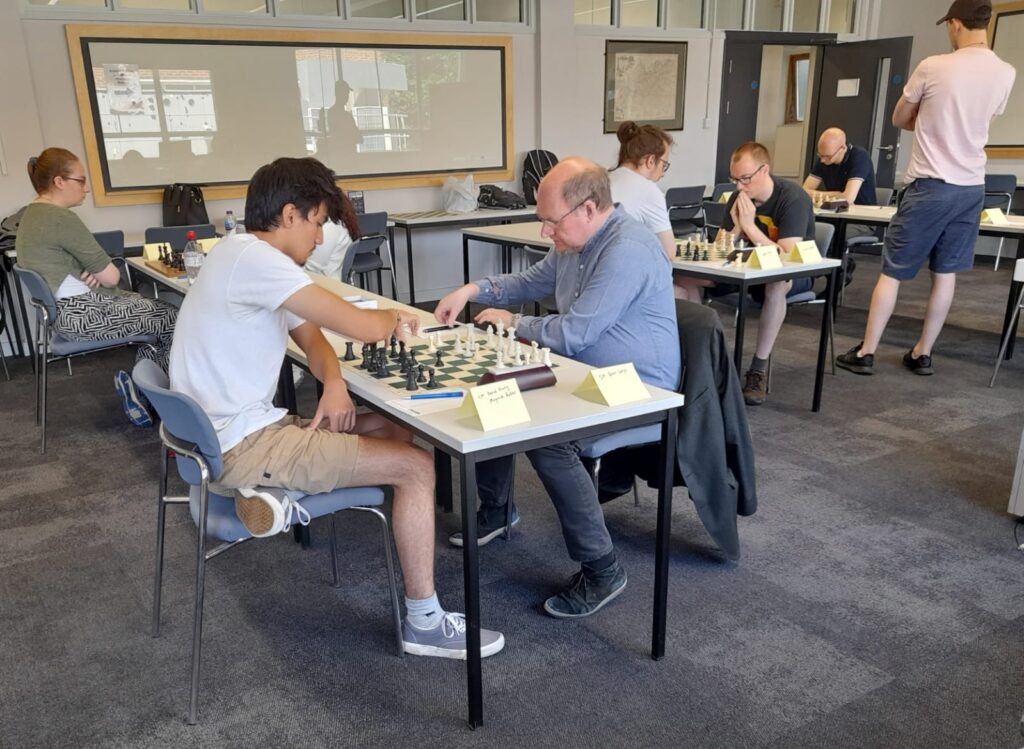
Olympiad team-mates Akshaya Kalaiyalahan and Zoe Varney had a hard-fought draw; Peter Lalić got the better of Steven Jones in an endgame in which Lalić’s two bishops were too strong for Jones’ rook; and Will Taylor held firm against a slashing attack and piece sacrifice from the ever effervescent Mike Healey. The latter’s attack looked certain to break through and Healey ignored an immediate draw by perpetual because his assault looked overwhelming, but Taylor wriggled free to continue Healey’s rotten run.
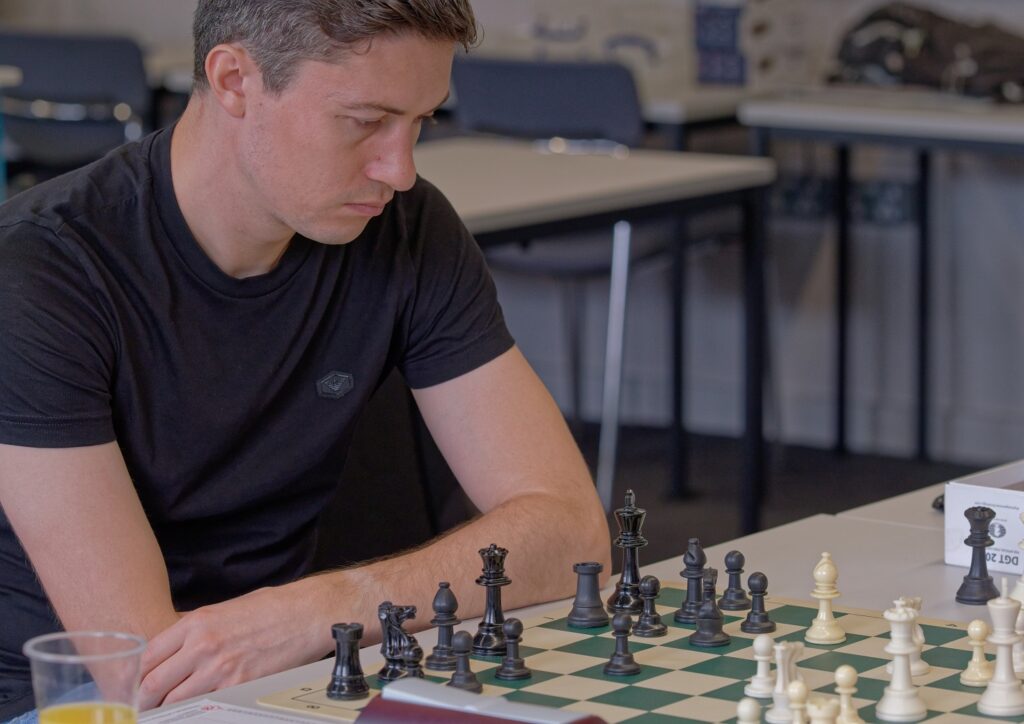
The game of the round – Tim Seymour, with White, against Peter Finn – also produced a draw, but it was the least peaceable draw you will ever see: a wild ride in which, at the end, Seymour had rook, two bishops and what looked like a mating attack, and Finn had queen and a passed pawn. No one had much idea how the game stood, both players were making desperately difficult choices on the increment, exhaustion was setting in, and peace was declared with smoke still rising from the battlefield.
After his defeat of Steven Jones and Peter Large’s loss to David Maycock, Peter Lalić was now in the lead by a point, and his excellent tournament continued in the afternoon session with a win with Black over Mike Healey. It was not without alarms, though, as Healey played with characteristic energy and imagination, sac-ing yet another piece, getting great piece activity and threatening mate even when the piece count had been greatly reduced. Nonetheless, Lalić weathered the storm and now had one hand on the trophy.
David Maycock, with White, defeated Tim Seymour, but the latter was disgusted by his endgame play when he gave up two pawns in a position that both players felt was objectively drawn. Seymour left the playing hall with an anguished expression – the pain perhaps exacerbated by the fact that the university locks all its doors at 6pm on Saturday and, as the last people in the building, we had to find a labyrinthine way out, thwarting the quick exit he clearly craved.
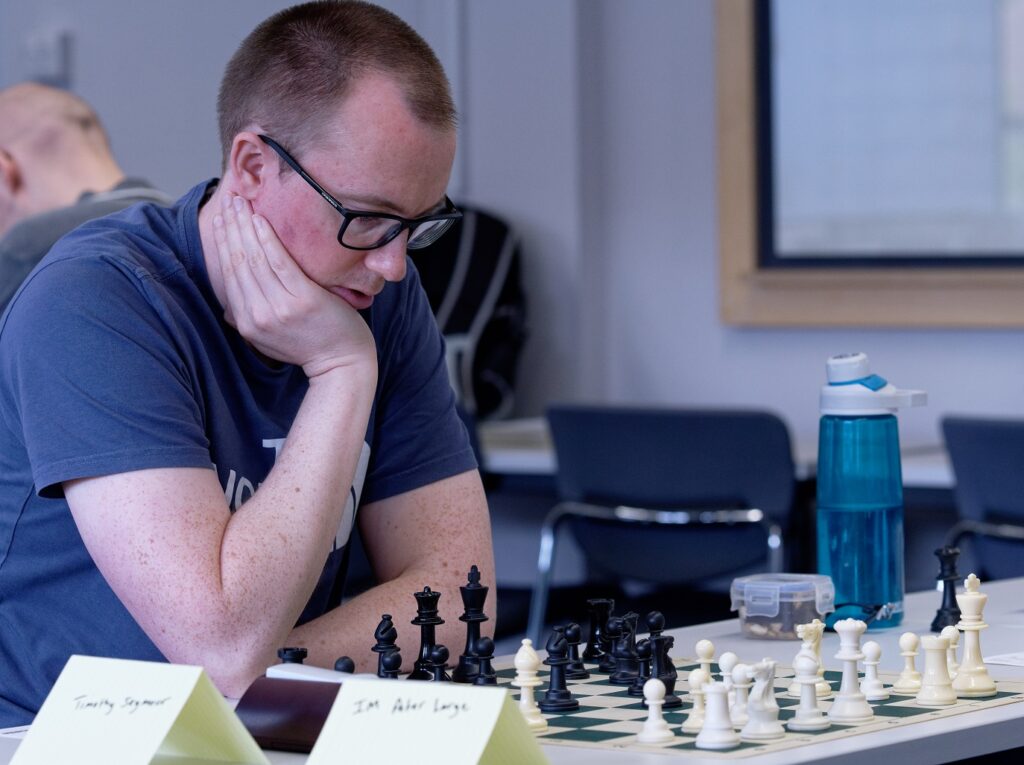
Zoe Varney, with White, gave Peter Large a tough game, but, with two bishops against two knights and an advantage on the clock, Large always looked the likelier winner and so it proved. Steven Jones had rook and pawn to rook in an endgame with Akshaya Kalaiyalahan, but accepted it was a theoretical draw. And Peter Finn, with Black, won a tremendous game against Will Taylor that was on a knife edge throughout. Finn has been playing gloriously dynamic and risk-taking chess all week and it was good to see him getting some reward, though Taylor, who has himself contributed greatly to the event, may beg to differ.
With one round left, Lalić was in pole position with 6.5/8, closely followed by Maycock and Large with 5.5. Lalić would have White in the final round against Taylor, and, while he would not thank you for saying it (because Peter would argue it piles up the psychological pressure), it really is his to lose.
Day 5 24 July
In the end, there was no shock. Peter Lalić and Will Taylor played out a 16-move draw which ensured Lalić took first prize, but there was no prearrangement and no five-move joke game. Lalić stuck to the 1. h3 he has been playing with great success throughout the tournament, the bishops quickly came off, and a draw was agreed in a rather tepid position of undoubted equality.
Lalić was a worthy winner of the event, scoring 7/9, adding more than 40 Fide rating points and (subject to Fide confirmation) passing the 2200 barrier which allows him to claim candidate master status. Congratulations to Peter, who prepared brilliantly for the tournament and showed what one seasoned observer at the event described as “impressive control in sharp positions and a consistent level of play overall”.
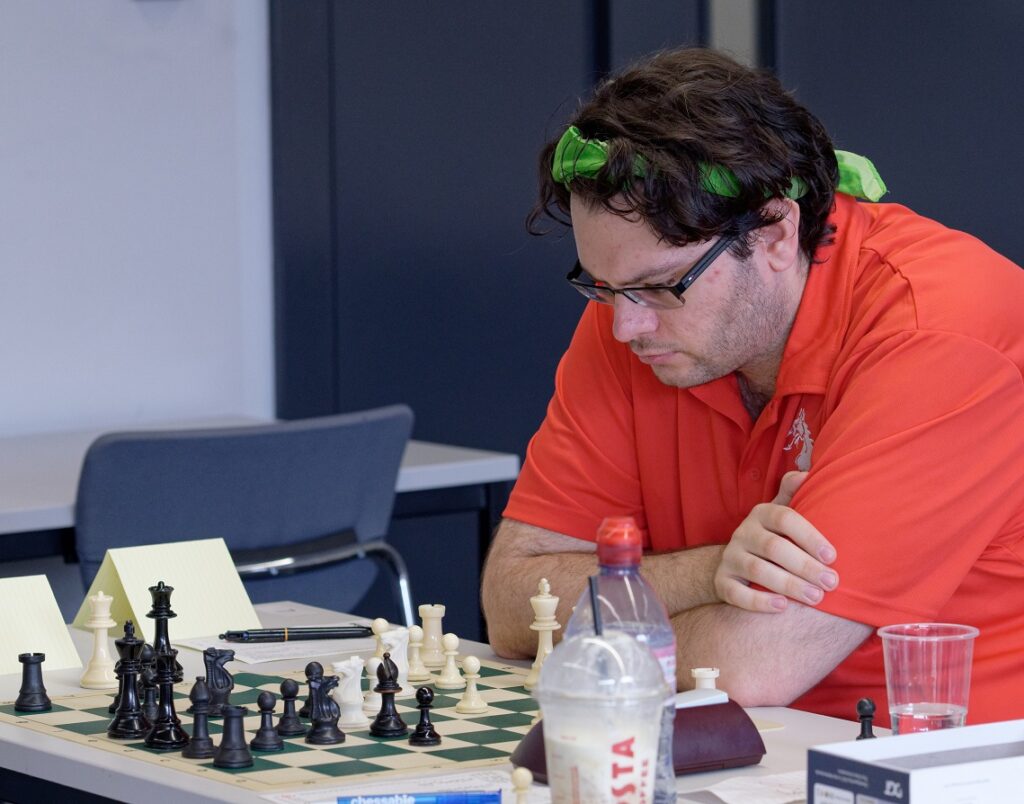
In the other games, David Maycock confirmed his position in joint second (on 6.5/9) with a fine win over Peter Finn, exploiting the light squares to powerful effect; Peter Large, the other player in joint second, beat Steven Jones in a game which Large said was the first of the week where his preparation actually paid off; Mike Healey defeated Akshaya Kalaiyalahan in a violent (metaphorically speaking) game that could have gone either way; and Tim Seymour won a bishop v bishop endgame against Zoe Varney.
Incredibly, after their near-40 hours of tough classical chess, most of the players retreated to the analysis room to play blitz, ignoring the tournament organiser’s cries that the sun was shining and there was surely more to life than chess. We did manage to get them to take a brief break from the 64 to allow Kingston club president John Foley to present the cup for the 1st Kingston Invitational and a prize of £250 to Peter Lalić, and prizes of £75 to Peter Large and David Maycock for their joint second places.

Everyone appeared to enjoy the tournament, and the organisers – perhaps foolishly – said the event would definitely be repeated next year. Calling it the “1st” Kingston Invitational always was a dangerous hostage to fortune.
Tournament reports by Vladimir Li, Julian Way, Nick Grey and Stephen Moss

